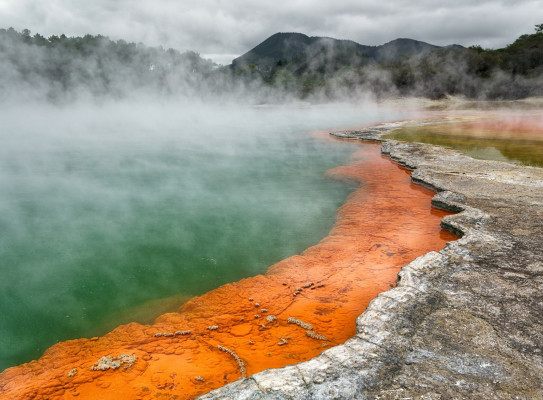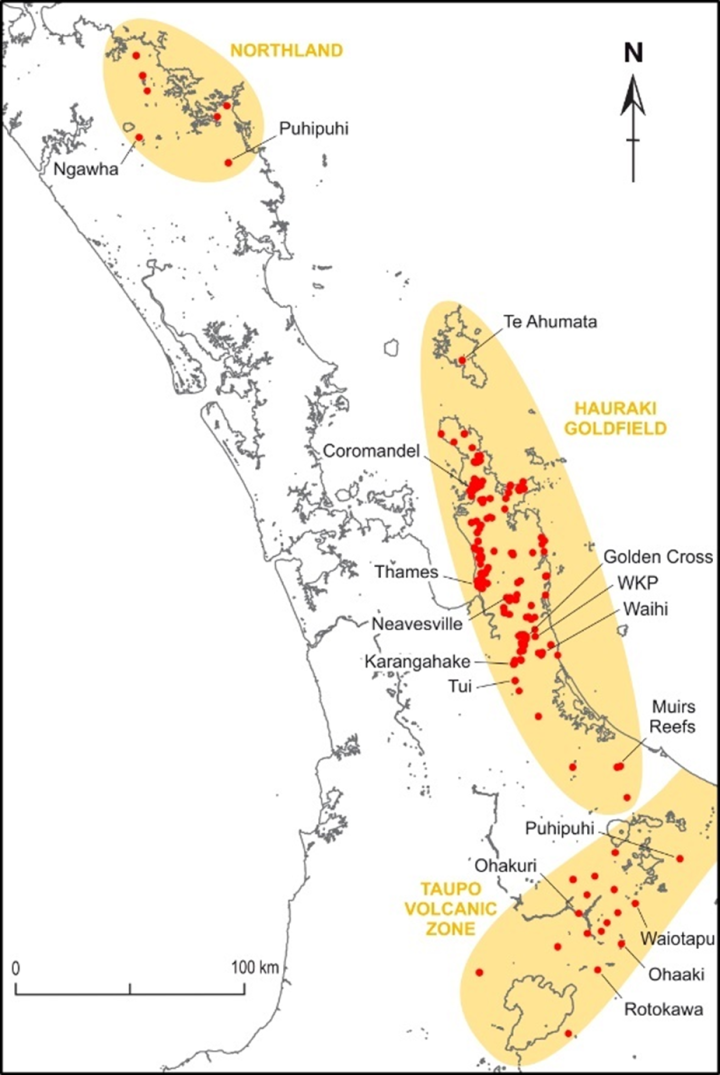Epithermal

Epithermal gold and silver deposits are among the most significant sources of precious metals worldwide. Forming at shallow depths (typically <1 km) and moderate temperatures (100–300°C), these deposits are found in active and ancient volcanic regions, often associated with geothermal systems.
New Zealand Epithermal Gold Deposits
Introduction
Epithermal gold-silver deposits in Northland and the Hauraki Goldfield (including Great Barrier Island and the Coromandel Peninsula) formed in ancient geothermal systems active during the Miocene–Pliocene. Today, similar processes are occurring in active geothermal systems within the Rotorua–Taupō Volcanic Zone, where gold is still being deposited in modern epithermal environments.
Hauraki Goldfield: A Historic and Active Gold Province
The Hauraki Goldfield is one of New Zealand’s most significant gold-producing regions, containing around 50 known epithermal gold-silver deposits. Since the 1860s, mining operations have extracted approximately 45 million ounces of gold-silver bullion, primarily from quartz veins hosted in andesite and dacite.

-
Key Deposits and Mining Operations
- Martha Mine (Waihi): The largest producer in the Hauraki Goldfield, yielding 35 million ounces of gold and silver bullion between 1878 and 1952 from the Martha vein system by underground mining. The mine was reopened as an open pit in 1988, with underground mining below the open pit beginning in 2005. New vein discoveries such as Favona, Trio, and Correnso extended the mine’s life.
- Talisman Mine (Karangahake): Another historic producer of gold and silver, actively explored since the 1970s. Recent work by New Talisman Gold Mines Ltd has identified new gold-silver resources for underground mining.
- Wharekirauponga (WKP): A significant recent discovery, 12 km north of Waihi, demonstrating the potential of rhyolite-hosted gold deposits in the Hauraki Goldfield. Historically, rhyolitic rocks were considered low-priority targets, but this discovery has renewed exploration interest.
-
Northland Epithermal Prospects
- Northland also hosts several epithermal deposits, including hot spring-type systems with evidence of past mineralisation:
- Puhipuhi (north of Whangārei): Small-scale silver and mercury production occurred here historically. Drilling has intersected gold-bearing quartz veins with potentially economic grades.
- Ngawha (near Kaikohe): Historically produced mercury, with potential for epithermal gold-silver mineralisation.
-
Modern Epithermal Activity in the Taupō Volcanic Zone
Today, gold and silver continue to be deposited in active geothermal systems of the Taupō Volcanic Zone. Several epithermal gold-silver prospects have been identified in the region, including:
- Ohakuri Prospect
- Forest Road Prospect
Exploration Potential and Opportunities
The Hauraki Goldfield remains highly prospective, with several key exploration targets:
- Extension of known epithermal veins – both down-dip and along strike.
- Gold deposits in rhyolitic rocks – recent discoveries like Wharekirauponga challenge the traditional focus on andesite and dacite-hosted deposits.
- Blind deposits under younger volcanic cover – hidden veins, especially beneath younger rhyolites, present exciting new targets.
As exploration continues, modern geophysical, geochemical, and structural techniques are unlocking new opportunities for gold-silver discoveries in New Zealand’s epithermal systems.
Formation and Key Characteristics
Epithermal deposits develop from metal-rich hydrothermal fluids that rise from deep magmatic sources. As these fluids ascend and interact with cooler groundwater, temperature, pressure, and chemical conditions change, triggering the deposition of gold, silver, and associated minerals. The key processes driving mineralisation include:
- Boiling: A major control on gold precipitation. As fluids reach shallow levels, rapid pressure drop causes boiling, leading to gas loss (e.g., H₂S) and gold deposition.
- Fluid Mixing: When deep magmatic fluids mix with meteoric (surface-derived) waters, changes in pH and redox conditions promote metal precipitation.
- Wall Rock Interaction: Hydrothermal fluids alter surrounding rocks, creating distinctive mineral assemblages that serve as exploration guides.
These deposits occur in a range of geological settings but are most commonly associated with volcanic arcs, back-arc basins, and rift zones. Mineralisation is hosted in veins, breccias, and disseminations, with ore zones often displaying strong structural controls.
Classification of Epithermal Deposits
Epithermal systems are broadly classified into high sulphidation, low sulphidation, and intermediate sulphidation types. The classification is based on fluid chemistry, alteration styles, and ore mineralogy.
-
High Sulphidation Epithermal Deposits
- Formation: Formed from hot, acidic, oxidised fluids, often directly linked to magmatic degassing.
- Alteration: Intense leaching creates residual vuggy silica zones, surrounded by advanced argillic alteration (alunite, kaolinite, dickite, pyrophyllite, diaspore).
- Ore Minerals: Native gold, electrum, enargite, pyrite, covellite, chalcopyrite, galena, sphalerite, tellurides.
- Geological Setting: Found in volcanic arcs and subduction-related magmatic systems, commonly overlying porphyry copper-gold deposits.
- Example Deposits:
- Yanacocha, Peru (51 Moz Au)
- Pueblo Viejo, Dominican Republic (38 Moz Au)
- El Indio-Tambo, Chile (7 Moz Au, 60 Moz Ag) -
Low Sulphidation Epithermal Deposits
- Formation: Derived from near-neutral pH fluids, often influenced by meteoric waters circulating in geothermal systems.
- Alteration: Quartz-chlorite-carbonate-pyrite alteration dominates, with quartz-adularia-illite (sericite) alteration bounding the veins and illite-smectite-carbonate in outer lower temperature alteration zones.
- Ore Minerals: Gold occurs with silver as electrum in quartz veins, with minor sulphides (acanthite, pyrite, sphalerite, galena, chalcopyrite, sulphosalt minerals).
- Geological Setting: Found in extensional terrains and rift-related volcanic settings.
- Example Deposits:
- Waihi, New Zealand (8 Moz Au)
- Hishikari, Japan (14 Moz Au)
- Roșia Montană, Romania (50 Moz Au) -
Intermediate Sulphidation Epithermal Deposits
- Formation: Represent a transitional style between high and low sulphidation systems, with mixed fluid compositions.
- Alteration: Broad spectrum of alteration minerals, including sericite, chlorite, and carbonate minerals.
- Ore Minerals: Gold in Ag-rich electrum is commonly associated with acanthite, tetrahedrite, sphalerite, and galena, forming polymetallic veins.
- Example Deposits:
- Fresnillo, Mexico (World’s largest primary silver producer)
- San Cristobal, Bolivia (Zn-Ag-Pb deposit)
Exploration Techniques for Epithermal Deposits
Successful exploration of epithermal systems relies on recognising key geological, geochemical, and geophysical indicators.
Alteration Zoning
- High sulphidation: Look for advanced argillic alteration with vuggy silica zones.
- Low sulphidation: Focus on quartz-adularia-illite-carbonate alteration and silicified zones.
Geochemical pathfinders
- Elements like arsenic (As), antimony (Sb), mercury (Hg), and tellurium (Te) often indicate proximity to mineralisation.
Structural controls
- Epithermal veins typically follow faults, fractures, and extensional structures.
Geophysical methods
- Magnetic and resistivity surveys help delineate structural controls and alteration halos
Sulphur as a vector:
- Sulphidation state of sulphide minerals can indicate deposit type and proximity to mineralisation
Use our web map(external link) on the epithermal mineral system to see the location of some key geologic features used for exploration.
Key Challenges and Emerging Insights
- Deep epithermal Settings: Some deposits extend to deeper levels, overprinting porphyry and iron oxide-copper-gold (IOCG) systems.
- Tectonic influence: Structural reactivation can remobilise gold, creating complex mineralisation patterns.
- Role of sulphur: The influence of sulphur-bearing fluids in epithermal vs. magmatic environments is still debated.
- Advancements in exploration: Machine learning, hyperspectral imaging, and AI-driven data integration are improving targeting success.
Economic Importance and Global Production
Epithermal deposits contribute significantly to global gold and silver production. Some key statistics:
- Epithermal deposits account for ~20% of primary global gold production.
- They are the world’s largest source of silver, historically mined since Spanish colonial times in Bolivia, Mexico, and Peru.
- Several epithermal districts exceed 10 Moz Au production, with some (e.g., Yanacocha, Hishikari) ranking among the richest globally.
Conclusion
Epithermal gold and silver deposits remain a cornerstone of precious metal exploration, offering high-grade, large-volume opportunities in geologically active regions. Advances in geological modelling, geochemistry, and geophysics continue to refine exploration strategies, ensuring that these deposits remain at the forefront of mineral exploration and development.
References
Christie AB. 2019. Introduction to New Zealand hard rock gold deposits and their exploration models. New Zealand Journal of Geology and Geophysics. 62(4):394–413. https://doi.org/10.1080/00288306.2019.1653328(external link)
Christie, A. B., Simpson, M. P., Barker, R. G., and Brathwaite, R. L. 2019. Exploration for epithermal Au–Ag deposits in New Zealand: history and strategy. New Zealand Journal of Geology and Geophysics, 62(4): 414–441. https://doi.org/10.1080/00288306.2019.1677251(external link)
Corbett, G.J., and Leach, T.M. 1998. “Southwest Pacific Rim gold-copper systems: Structure, alteration, and mineralization.” Society of Economic Geologists Special Publication, 6: 237-249.
Hedenquist, J.W., Arribas, A.R. and Gonzalez-Urien, E. 2000. Exploration for Epithermal Gold Deposits. Reviews in Economic Geology, 13: 245-277.
Hedenquist, J.W., and Lowenstern, J.B. 1994. “The role of magmas in the formation of hydrothermal ore deposits.” Nature, 370: 519-527.
Heinrich, C.A., and Driesner, T. 2010. “Hydrothermal ore formation in the Earth’s crust: Insights from physical modeling.” Reviews in Economic Geology, 17: 245-270.
Sillitoe, R.H., and Hedenquist, J.W. 2003. “Linkages between volcanotectonic settings, ore-fluid compositions, and epithermal precious metal deposits.” Society of Economic Geologists Special Publication, 10: 315-343.
White, N.C., and Hedenquist, J.W. 1995. “Epithermal gold deposits: Styles, characteristics, and exploration.” Society of Economic Geologists Newsletter, 23: 9-13.